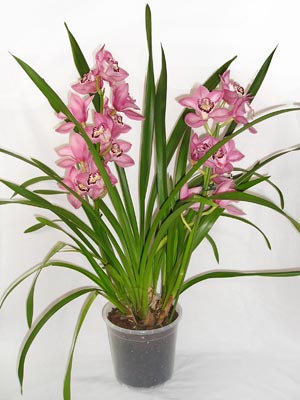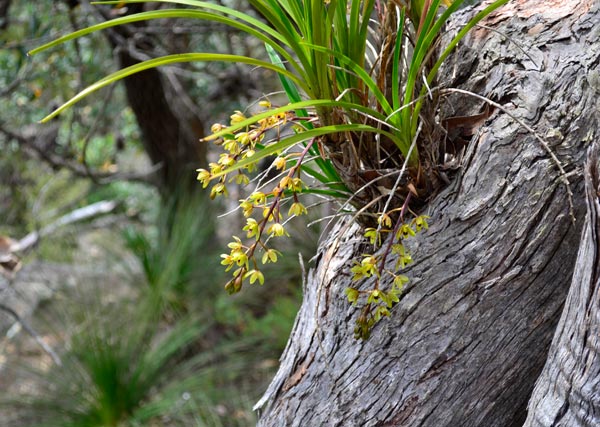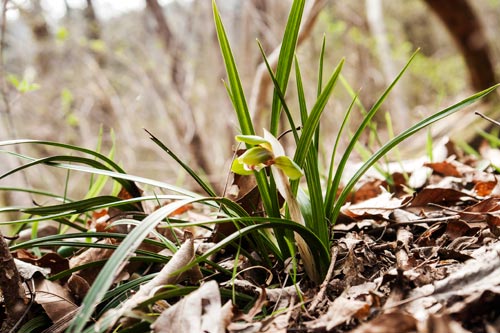

 Cymbidium orchid care requires careful attention to temperature changes throughout the year. Photo Maja Dumat
Cymbidium orchid care requires careful attention to temperature changes throughout the year. Photo Maja DumatCymbidium orchids are very well known houseplants, but their flowers are also often included in floral arrangements or used in an orchid corsage. The flowers are long-lasting, quite large, and are naturally very attractive. They bloom just once each year, during the winter, though a plant may have numerous flower spikes at the same time. Cymbidium orchid care is not difficult, though it is not as straight forward as the care for plants that like more-or-less the same conditions all year round, such as Phalaenopsis.
The Cymbidiums available today can be split into two approximate groups: miniature and standard. The mini Cymbidium orchids, as the name implies are petite in size, and favor warmer climates. The standard size has sprays of large flowers; these plants are the ones so readily available in florists, and sold as cut flowers.
In Asia, Cymbidium orchids have been cultivated for over a millennium. A Cymbidium orchid was first described in western science in 1799 by Olof Swartz. The Cymbidium name is derived from the Greek word “kumbos”, which means cavity, a reference to the shape of the flower's lip. Their popularity increased in Europe through the 19th and 20th centuries, in which time thousands of very attractive hybrids emerged. The genus contains 52 species, but only a few of them are grown commercially, since the majority of Cymbidium orchids for sale are hybrids between different parent species.
With so many hybrids in existence, each sharing traits with two or more Cymbidium orchids, plants can have quite different characteristics and requirements. Add in a little selective breeding, and a little more natural selection, and it soon becomes impossible to predict a plants needs with certainty. Luckily hybrids are often very forgiving plants, more suited to home living than their wild ancestors. But it is so important to watch a plants response to it's environment. Only a happy plant will flower!
 A Cymbidium orchid growing as an epiphyte in a cavity in a tree. Photo Doug Ford
A Cymbidium orchid growing as an epiphyte in a cavity in a tree. Photo Doug FordAlthough hardy, these plants may not be for the beginning grower, as they have quite particular needs, especially when it comes to reflowering. Certainly something to think about before you buy a Cymbidium orchid. They are not the kind of plant you can put on a window sill and forget about.
Cymbidium orchids are typically large, hardy, semi-terrestrial plants. In warmer parts of the world they can even be kept as garden plants.
So what's the problem?. Well, orchids in this genus regularly grow at high altitudes, the Himalayas amongst other places; a fact that must be remembered when we keep Cymbidium orchids as houseplants. These places can get quite hot in summer and very cool in winter. For example, the epiphyte Cymbidium devonianum from Nepal lives at altitudes of up to 2000m. Conditions change the higher the altitude, but in Kathmandu, for example, which is at 1400m above sea level, summer temperatures (min/max) vary between 70°F/86°F (21°C/30°C); whilst winter is much cooler: 35°F/66°F (2°C/19°C). Like other higher altitude orchid species (Dendrobium nobile immediately springs to mind) this cool winter period is essential to initiate flowering the following season. Care of orchids as houseplants most likely will involve relocating your plants from time to time to simulate the temperature changes these plants experience in the wild. Cymbidium orchid care is easy if you have a greenhouse and a garden. If not you may well experience difficulty in keeping them.
 Cymbidium goeringii is a Japanese terrestrial species, that has pseudobulbs that remain underground. Photo 영철 이
Cymbidium goeringii is a Japanese terrestrial species, that has pseudobulbs that remain underground. Photo 영철 이Cymbidium orchids naturally occur through China, Taiwan, Korea, Japan, Malaysia, Borneo, the Philippines, the Himalayas India and northern Australia. Different species have adapted to different lives, in different parts of the world. Many grow as epiphytes, living on tree branches; or lithophytes, on mossy rocks; others still grow fully terrestrially, some with pseudobulbs beneath the surface. Some plants come from regions with no elevation above sea level, whilst others exist at altitudes of up to 3000m. Generally the miniature species are lowland tropical plants, and can tolerate much warmer fall conditions and still flower. These have a greater tendency to be epiphytic. The majority of hybrids, however, are related to the large-flowered upland species, and are more likely to be found growing terrestrially.
Although some wild-type Cymbidium species are available from specialist breeders, the majority of plants seen for sale are hybrids, with their own requirements and characteristics.
Unlike many simpler orchid species, the care regime for highland Cymbidium orchids changes with the seasons, and is as follows:
SPRING The start of the growing season. Keep in a Greenhouse, conservatory or warmer garden. Failing this, the coolest indoor position available. Provide as much sun as possible. Water sparingly. Don't let the pot dry out. Watch out for new pseudobulbs.
SUMMER Active growth phase. Move the plant to a sheltered position in the garden. Cymbidium need good light, the garden is the perfect place for them. These orchids enjoy the morning and afternoon sun, and strong light is essential during this growing season. Cymbidiums are able to tolerate summer heat, and in cooler regions of the world, even full mid-day sun. But do not let leaves burn. Water at least once/week; keep medium moist in hot conditions.
FALL Flower spikes form in early autumn. A few weeks with a significant day/night temperature difference is essential. Move plants to a a greenhouse only when night time temperatures drop to 40°F/5°C. Take care, Cymbidium orchids are very sensitive to heat at this time: keep the plants below 68°F/20°C, whilst the buds are developing. Too much warmth will result in bud blast; the buds turn yellow and fall off.
WINTER Cymbidium flower in winter. Plants can remain in the greenhouse, however once all flowers have opened, they are safe to bring into a warm house, where they should last for at least one month. Once all flowers have dropped, cut off the flower spike, and seal with a dab of cinnamon powder. When all flowers are gone, the plant can be returned to the greenhouse for spring. Allow the pot to become almost dry before rewatering.
Proving your orchid with a well-draining medium is an essential part of proper Cymbidium orchid care. This plant will certainly not do well in a soggy, non-draining medium. In mild summer climates, fir bark mix for terrestrial orchids is ideal. In warmer summer areas, a finer orchid mix containing peat, sphagnum moss, fir bark and perlite is recommended. Lowland epiphytic species can be kept purely in fir bark.
Cymbidium orchids need strong light. Species (and cultivars thereof) that come from deciduous forests experience strong light early in the year. Because upland species prefer cooler conditions than most orchids we consider houseplants, the greenhouse, a cool conservatory and the garden really are the best spots. Ideally place your Cymbidium orchid in a spot where it will get very good light, but be protected from strongest mid-day sun, and too much rain. If the leaves begin to turn yellow, your Cymbidium orchid might be exposed to too strong sun light. If the leaves instead develop an unusually dark green shade, this is an indication that the orchid is not receiving enough light.
Giving the orchid the ideal amount of water is a very important aspect of Cymbidium orchid care. In this regard, Cymbidium orchid care is a constant balancing act. Cymbidiums should not be allowed to dry out completely, yet should not become saturated either. Watering the orchid every 7 to 10 days is a good rule of thumb, but you may need to modify this rule to suit your particular conditions since air humidity, room temperature etc. play an important role here. Watering should always occur in the morning, giving the plant time to drain and dry before evening. Use aged tapwater, distilled water or rainwater. (For more about water useage with orchids, see what water for orchids). A soggy environment should definitely be avoided, as this can result in root rot. Likewise, do not get flower spikes wet! Generally, pushing a finger an inch into the medium will tell if it is still moist. If in doubt, leave it another day. As is the case with all orchids, over-watering is far more likely to kill a Cymbidium than under-watering. A sign of under-watering is shrivelled pseudobulbs. If this occurs, and your medium is dry, it'd definitely time to water.
Cymbidium orchid care calls for two types of fertilizers: high nitrogen and low nitrogen. Use a high nitrogen fertilizer (such as 25-9-9) in the spring and early summer (growing season), and a low nitrogen fertilizer (such as 6-25-25) from late summer through fall. Feeding in winter is not necessary. The suggested monthly fertilizer dose is best split and fed weekly. Growers using tap water tend to half this dose again, to allow for all the nutrients already present in typical tap water.
Repotting your orchid every second or third year is an important part of good Cymbidium care. The recommended repotting period is after flowering and before the growing season is in full swing. Because Cymbidium are sympodial plants (i.e. new growth appears from one end of the plant rhizome), the plant should be positioned off-center, with the new growth near the middle of the new pot, and older growth towards the edge. But when repotting a large Cymbidium, it can be a good idea to split the plant. It can be broken into sub plants, even as small as a single pseudobulb, and each can be repotted.
Cymbidium orchids for sale in florists are grown in large numbers by specialist nurseries, such as Duckitt nurseries in Darling, South Africa.
Cymbidium flowers come in every shape, size and color. Have a look at some of the amazing Cymbidium orchids for sale below
Some of the many species are explored below: